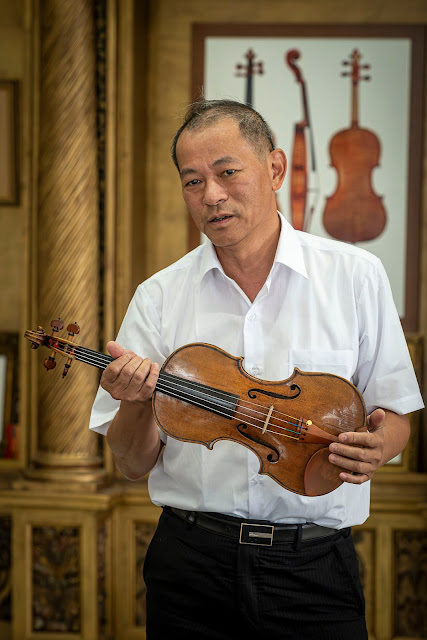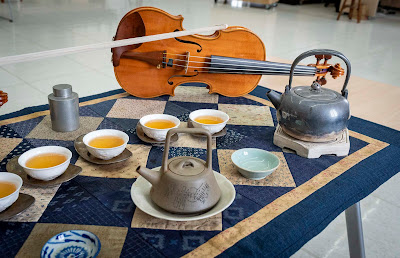Il faut surtout que vous sachiez que la collection de violons de la fondation Chimei est la première collection de violons au monde. De loin. Même en combinant les 5 prochaines collections, il n'est pas certain qu'on arrive au niveau de ce que possède Chimei (une entreprise Taiwanaise qui a fait fortune dans les écrans plats).
Ainsi, rien que les 6 violons que M. Chung a disposé pour l'appréciation de mon ami valent plus de 100 millions de USD! Le plus célèbre d'entre eux est le "Ole Bull", du nom d'un musicien Norvégien qui l'a possédé et qui fut fabriqué en 1744 par Garneri "del Gesu". La plupart des autres sont des Stradivarius.
Et pendant que ces messieurs parlent violon, je dispose mon Chaxi sur cette table. Mon vieux panier en osier fait le pont entre mes accessoires de thé et les violons! Mais M. Chung n'est pas confortable à l'idée d'avoir de l'eau bouillante à si grande proximité de ses précieux violons (je le comprends) et je trouve une autre table pour infuser mon thé:
Un autre groupe de visiteurs VIP Japonais arrive lorsque je commence mes infusions depuis ma nouvelle table, située à proximité d'un dispensateur d'eau bouillante. |
| M. Chung tient le 'Ole Bull' |
M. Chung présente les pièces maitresses de la collection aux visiteurs et Michael Zuber leur offre un petit concert improvisé avec ce violon d'exception:
Il joue la sonate de JS Bach pour violon No 1 en G mineur, BWV 1001: I, Adagio.
Le son est d'une puissance incroyable. Et d'une pureté! J'en ai des frissons rien qu'au souvenir! Puis, Michael enchaine les différents violons pour les jouer chacun et apprendre à mieux connaitre leur type de son, quelle musique leur convient le mieux. Bach, Mozart, Vivaldi... le son de chaque violon lui donne envie de jouer un compositeur différent, en fonction du violon, mais aussi de l'archet! Et c'est là que je me rends compte qu'on a la même chose dans le thé avec la théière d'Yixing et les coupes de porcelaine. Il s'agit aussi de trouver l'harmonie entre ces 2 accessoires et le thé infusé!
A occasion exceptionnelle, un Chaxi exceptionnel:
A occasion exceptionnelle, un Chaxi exceptionnel:
1. Le thé: mon Dong Ding Oolong de Feng Huang du printemps 1980. Pourquoi ce thé? Je voulais un thé de collection qui s'est bonifié avec le temps, comme ces Stradivari. De plus, comme le fondateur de Chimei est très attaché au terroir de Taiwan, je voulais des feuilles locales.
2. Ma théière d'Yixing en glaise Duanni avec une anse difficile à réaliser et joliment décorée, des années 1930.
3. Une bouilloire en argent pour une pureté maximale de l'eau.
4. Une jarre en étain du Japon pour conserver au mieux mon thé.
5. 3 petites assiettes anciennes. La céladon (pour les feuilles), la qinghua (pour le couvercle) de la fin Qing et l'assiette en porcelaine de la dynastie Song (sous la théière). Cette dernière assiette a impressionné M. Chung, car elle est bien plus ancienne que ses violons!
6. Un Jian Shui en étain
7. Les coupes en porcelaine de DeHua du Fujian et leur socle en cuivre et argent du Japon.
Le tout est disposé sur un Chabu réalisé à la main par ma mère avec des tissus trouvés à Taiwan!
Le tout est disposé sur un Chabu réalisé à la main par ma mère avec des tissus trouvés à Taiwan!
L'infusion est magnifique. Comme Bach sur le violon Ole Bull, ce Dong Ding de 1980 résonne dans nos palais avec puissance, pureté et toute la vigueur d'un Oolong plein de vie. Michael me fait confiance et dispose 2 de ses violons et un archet sur mon Chaxi afin d'encore mieux symboliser ce mariage musical et gustatif.
Or, avec Bach et Dong Ding, nous retrouvons la beauté intemporelle des plus grands classiques. Ils sont interprétés avec une profondeur incomparable dans ces accessoires anciens (violon Ole Bull de 1744 et Yixing Duanni des 1930s). Or, Michael m'apprend que comme une théière qu'on culotte, le son d'un violon se travaille également: à force de bien jouer avec un violon, son son s'ouvre et il sonne de mieux en mieux. Ainsi, Michael me dit qu'il avait pu jouer avec des violons de violonistes célères et le son produit ressemblait à celui de leur propriétaire. Ce n'est qu'au bout de quelques semaines que le violon va s'imprégner du son du nouveau joueur (à moins de ne pas avoir une bonne technique et alors même un très bon violon ne sert à rien, comme pour le thé!)
Le silence après Bach fait résonner sa musique en écho en nous, tout comme la longueur en bouche du thé crée une présence dans ces arômes qui n'en finissent pas de finir et nous touchent au plus profond de nous-même. Et les notes de vieux bois du Dong Ding font justement écho à la beauté du bois laqué des Stradivarius.
Or, avec Bach et Dong Ding, nous retrouvons la beauté intemporelle des plus grands classiques. Ils sont interprétés avec une profondeur incomparable dans ces accessoires anciens (violon Ole Bull de 1744 et Yixing Duanni des 1930s). Or, Michael m'apprend que comme une théière qu'on culotte, le son d'un violon se travaille également: à force de bien jouer avec un violon, son son s'ouvre et il sonne de mieux en mieux. Ainsi, Michael me dit qu'il avait pu jouer avec des violons de violonistes célères et le son produit ressemblait à celui de leur propriétaire. Ce n'est qu'au bout de quelques semaines que le violon va s'imprégner du son du nouveau joueur (à moins de ne pas avoir une bonne technique et alors même un très bon violon ne sert à rien, comme pour le thé!)
Le silence après Bach fait résonner sa musique en écho en nous, tout comme la longueur en bouche du thé crée une présence dans ces arômes qui n'en finissent pas de finir et nous touchent au plus profond de nous-même. Et les notes de vieux bois du Dong Ding font justement écho à la beauté du bois laqué des Stradivarius.




























